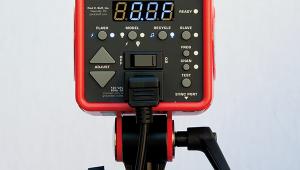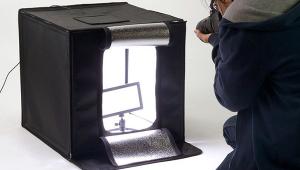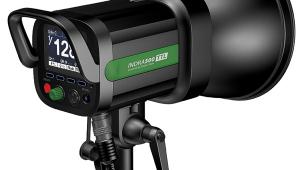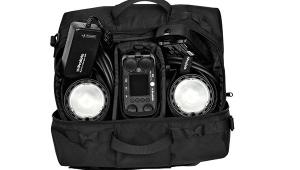Macro Ringlighting; We Review Flash, LED, And Fluorescent Ringlights
I prefer to shoot macros and close-ups handheld, so, when I need to augment the existing light or replace it entirely, I look for a compact solution. And for me, that often means a ringlight. It’s a simple and undemanding yet effective tool. For my really tight close-ups at or near life-size, I set focus manually in advance so there’s no worry about the AF sensor trying to lock on, particularly with a moving subject, and I physically move toward the subject with the camera until I achieve sharp focus.
 |
|
|
The typical ringlight is the one that features a one-piece fully circular tube. Other designs exist, and not only flash, as we’ll see in this collection. In this article we’ll look at the Sunpak Auto 16R Pro ring flash (which also operates stroboscopically); another Sunpak, the DSLR67 LED ringlight (this one hangs suspended in front of the lens); the Digi-Slave Flex-Ring 6400 LED ringlight (with two heads attached, and it flashes); the Promaster MacroLume TTL Digital ring flash (which can also sit atop the camera and double as a shoe-mount); the Metz Mecablitz 15 MS-1 Digital ring flash (wireless TTL support for multiple cameras, with pivoting heads); the Samigon Halo-Light FRL-1 (the only fluorescent ringlight in the group); and ExpoImaging’s Ray Flash (more of a beauty light for portraiture that doubles as a macro ring flash in a pinch—and it’s not really a flash). I did all my testing with a Nikon D300 and an AF-S Micro Nikkor 60mm, shooting handheld. Yes, there are more products available, which are shown in a sidebar (see “Ringlight Resource Guide”), but these are the ones I worked with to get a real feel for this type of handy tool.
One thing to consider: the ringlight may require a separate mounting ring/adapter to connect the ring head to the lens. Ensure the unit will fit your lens, although third-party steppers should do the trick. A major concern is vignetting with ringlights that are much smaller than the lens’ filter diameter.
Working With A Ringlight
Initially, we want that light to be even all around. But, as with anything we photograph, we have to tailor the light to the subject and its surroundings. Some ringlights provide a convenient means to achieve this goal.
For starters, unless the ringlight is a one-piece circular tube or a continuous array of LEDs, you can use the lamp configuration to create some modeling and give the subject more of a three-dimensional appearance or use it to reduce or overcome glaring reflections. Simply rotate the ring around the lens axis to a more advantageous position to alleviate annoying hot spots. Or you might prefer to accentuate the form of the subject by adjusting output on the various light heads (lighting ratio). You may need one half of the light to be extinguished entirely when, for instance, confronted by a curling leaf that might block light from that flash tube or a waxy leaf angled in such a way that it would throw back obtrusive reflections.
Of the ring flash units I worked with, those that afford individual control over light heads in some fashion or another are the Metz and Promaster. The Metz gives you lighting ratio control, whereas the Promaster inserts a diffuser to cut back on the light, while softening it. However, the Promaster’s diffusion also adds a distinct warm color cast you should be aware of.
The Metz and Digi-Slave come with diffusion attachments—highly recommended for extreme close-ups. The Digi-Slave also has fully adjustable extension arms that can be used for modeling alone or in conjunction with the ringlight. The built-in reflectors, or heads, on the Metz can be pivoted inward to more fully encompass the subject. Interestingly, the Samigon has a “blind spot” at the base, which can be used to add modeling when the ring is rotated to the necessary position. And the Sunpak LED ringlight can be twisted (just be careful not to block the lens) to provide modeling.
 |
|
|
Ringlights: A Few Provisos
You may want to revert back to autofocusing when shooting at magnifications less than life-size, at a point when it again becomes practical. However, manufacturers caution that you should use manual focus when a ringlight is attached to non-internal focusing optics. And I’ve read about problems when using AF with non-motorized lenses. These concerns don’t apply to the Sunpak LED or ExpoImaging Ray Flash, since they are not seated on the lens itself, but float in front of or around it.
What’s more, the battery housing on rings such as the Metz and Digi-Slave is an extension of the ring and may interfere with approaching your subject. Especially with subjects on a flat surface, you may find the extension scrapes the surface or otherwise prevents you from approaching your subject. Rotate the ring so that the extension sits on top—and be careful not to nudge it from this resting place, or it will swing back around to its default position.
 |
|
|
Also, cables may inadvertently swing around to the front of the lens, either when you’re rotating the ring or leaning over. So watch for that. This sure makes a wireless ringlight that much more appealing.
Another point, and something I hadn’t read about or noticed until now: the ring may produce reverse vignetting, an area in the center of the circle where the light fails to reach, when the ringlight comes too close to a surface/subject. The loss of light may not be a serious problem, but then again, it might be. A longer lens or diffuser may be an effective countermeasure to this phenomenon. Moreover, with LED ringlights, pulling back too far may also reveal a pattern from the bulbs. These effects are not readily observed on three-dimensional, textured, and highly detailed subjects, but aim the light at a white wall and they become apparent. If you notice your life-sized subjects are poorly illuminated toward the center, this may be the culprit. Also, when shooting at or near life-size, lens extension demands more light—a point to keep in mind.
 |
|
|
A Ringlight For Everyone
Shooting handheld to simulate field conditions, I photographed the same subject with each ringlight, at life-size, focusing on a detail of an antique silver bauble, and then the entire pendant. These tests proved very revealing.
Each one of the ringlights I worked with stands apart from the crowd owing to one or more unique features. My Top Pick was an easy choice: the Metz Mecablitz 15 MS-1 Digital, owing to its compact size, portability, ease of use as a wireless TTL slave flash (multi-channel/multi-group), and dedication to practically any popular camera (internally assigned via digital control). I do wish the heads pivoted at a 30? angle, but I’ll take the existing positions at 0, 10, and 20? (I use the 20? position mostly). And color balance was the best in the group. It came to be the standard by which all the other ringlights were judged.
The Sunpak Auto 16R Pro is a non-TTL ring flash that manages to provide some level of sophistication with digital control, and more importantly with the addition of a stroboscopic function. I liked the Promaster MacroLume TTL Digital because it offers full TTL control and effectively doubles as a shoe-mount—I just wish it came with popularly sized adapters. ExpoImaging’s Ray Flash was too large to be an effective ring flash, but it could prove handy if you don’t want to schlep around a second light, in addition to your shoe-mount. As for continuous lights, the Samigon Halo-Light FRL-1 fluorescent ringlight, while an interesting choice, requires six batteries, making it top heavy, and the true featherweight, the Sunpak DSLR67 LED ringlight, has difficulty staying put in front of the lens on its flexible arm. What’s more, the quality of light from both was poor, and output was so weak that I needed to use very high ISO levels. In contrast, the Digi-Slave Flex-Ring 6400 was clearly the front-runner among continuous light sources, outputting the most light in an efficient manner. However, while it offers a non-TTL Flash mode that essentially keeps pace with your camera’s Burst mode (there’s no flash capacitor, so no recycling), output does not compare to a true ring flash, and it lacks a focusing lamp in Flash mode. On the plus side, those extension arms provide considerable flexibility in lighting.
 |
|
|
There’s no question that ringlights can prove invaluable for close-up work, but fashion and portrait photographers find them attractive additions to their kit as well. So shop around (check our listings for many of the options offered) and find the one that’s right for you.
 |
|
|
Ringlight Resource Guide
Adorama DRF-14 Macro Ring Flash (www.adorama.com)—dedicated TTL models for Canon and Nikon; includes 55mm, 58mm, 62mm, and 67mm adapter rings ($139).
Bower SFDRL14 Ring Flash (www.bowerusa.com)—for Canon ($94) and Nikon ($110). The SFDRL Digital Macro Ring Light—rechargeable LED ringlight, supplied with 55mm and 58mm rings ($74).
Canon Macro Ring Lite MR-14EX (www.usa.canon.com)—features a split circular flash tube and full lighting ratio control, and clips directly on to most Canon macro lenses ($494).
Digi-Slave Flex-Ring 6400 (www.srelectronics.com)—an LED ringlight (64 LEDs) with two heads attached, and it flashes; 72mm thread ($359).
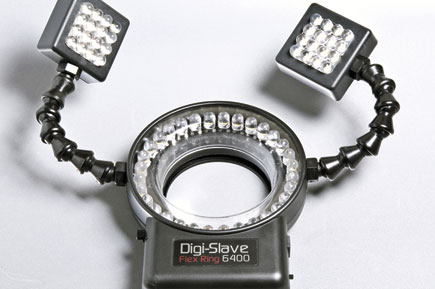 |
|
|
Dot Line RPS TTL Dedicated Macro Ring Flash (www.dotlinecorp.net)—for Canon and Nikon; includes 55mm, 58mm, 62mm, and 67mm adapter rings ($179).
- Log in or register to post comments






